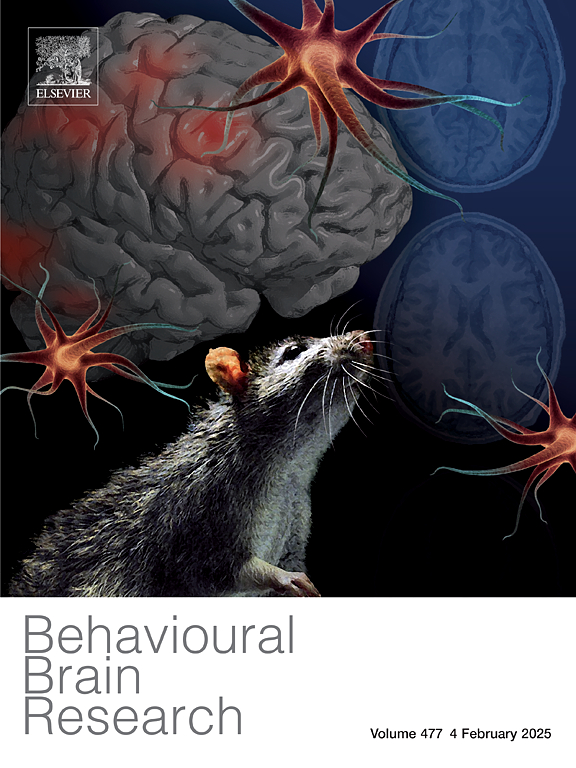An enriched environment during adolescence reduced ADHD-related behaviors in SHR and SLA16 male rats
IF 2.3
3区 心理学
Q2 BEHAVIORAL SCIENCES
引用次数: 0
Abstract
Environmental enrichment (EE) has emerged as a promising intervention capable of modulating behavior. The isogenic rat strains Spontaneously Hypertensive Rats (SHR) and SHR.LEW-(D4Rat76-D4Mgh11) (SLA16) share an identical genome, differing only in a specific region on chromosome 4. Despite this genetic similarity, these two strains exhibit notable behavioral differences, suggesting a potential influence of environmental and genetic factors. This study aimed to evaluate the effects of continuous EE (40 days, 8 different layouts) during adolescence on the behavior of SHR and SLA16 rat strains. A total of 48 male rats, aged 28 days, were assigned to four experimental groups: SHR-Standard Environment (SHR-SE), SHR-Enriched Environment (SHR-EE), SLA16-Standard Environment (SLA16-SE), and SLA16-Enriched Environment (SLA16-EE) and the following behavioral tests were conducted: Open Field (OF), Marble Burying (MB), Elevated Plus-Maze (EPM), Activity Cage (AC), Novel Object Recognition (NOR), and Plus Maze (PM). Environmental effects were observed in locomotion parameters in the OF, AC, and PM tests (EE < SE); in exploration of aversive areas in the OF and EPM tests (EE < SE); in stereotyped behavior in the MB test (EE < SE); in novelty preference in the NOR and AC tests (EE < SE); and in memory and attention parameters in the PM test (EE > SE). In conclusion, EE demonstrated beneficial effects on the behavior of SHR and SLA16 rat strains and may be considered a potential non-pharmacological intervention strategy for future evaluation in Attention-Deficit/Hyperactivity Disorder individuals.
青春期丰富的环境减少了SHR和SLA16雄性大鼠的adhd相关行为。
环境富集(EE)已成为一种有前途的干预措施,能够调节行为。等基因大鼠自发性高血压大鼠(SHR)和SHR. lew -(D4Rat76-D4Mgh11) (SLA16)具有相同的基因组,仅在4号染色体上的特定区域有所不同。尽管有这种遗传相似性,这两个菌株表现出显著的行为差异,表明环境和遗传因素的潜在影响。本研究旨在评价青春期连续情感表达(40天,8种不同布局)对SHR和SLA16大鼠品系行为的影响。选取28日龄雄性大鼠48只,分为标准环境(SHR-SE)、强化环境(SHR-EE)、标准环境(SLA16-SE)和强化环境(SLA16-EE) 4个实验组,分别进行开阔场地(of)、大理石埋地(MB)、高架+迷宫(EPM)、活动笼(AC)、新目标识别(NOR)和强化迷宫(PM)等行为学测试。在OF、AC和PM试验中观察到环境对运动参数的影响(EE < SE);在of和EPM测试中探索厌恶区域(EE < SE);刻板行为在MB测试中的差异(EE < SE);NOR和AC测试的新颖性偏好差异(EE < SE);PM测试(EE > SE)中记忆和注意参数的差异。综上所述,情感表达对SHR和SLA16大鼠品系的行为有有益影响,可能被认为是一种潜在的非药物干预策略,可用于未来对ADHD个体的评估。
本文章由计算机程序翻译,如有差异,请以英文原文为准。
求助全文
约1分钟内获得全文
求助全文
来源期刊

Behavioural Brain Research
医学-行为科学
CiteScore
5.60
自引率
0.00%
发文量
383
审稿时长
61 days
期刊介绍:
Behavioural Brain Research is an international, interdisciplinary journal dedicated to the publication of articles in the field of behavioural neuroscience, broadly defined. Contributions from the entire range of disciplines that comprise the neurosciences, behavioural sciences or cognitive sciences are appropriate, as long as the goal is to delineate the neural mechanisms underlying behaviour. Thus, studies may range from neurophysiological, neuroanatomical, neurochemical or neuropharmacological analysis of brain-behaviour relations, including the use of molecular genetic or behavioural genetic approaches, to studies that involve the use of brain imaging techniques, to neuroethological studies. Reports of original research, of major methodological advances, or of novel conceptual approaches are all encouraged. The journal will also consider critical reviews on selected topics.
 求助内容:
求助内容: 应助结果提醒方式:
应助结果提醒方式:


